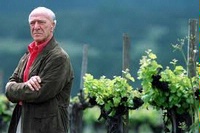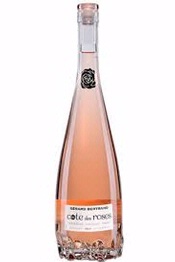|
|
 |
|
July 21, 2016
One of our top wine picks recently was the 50th
anniversary wine from Robert Mondavi, probably the most renowned winery
in California's Napa Valley.
The 50th anniversary is an important milestone to be sure, but
longevity alone is not what makes the occasion significant. Many among
the current generation of California wine enthusiasts weren't born yet
when Robert Mondavi parted ways with the family winery, Charles Krug,
and founded his namesake winery in 1966.
 It was a time when California wine was regarded with suspicion and
seldom found on the best restaurant wine lists of the day. Mondavi made
it his mission in life to bring California wine to the best tables in
the land. It was a time when California wine was regarded with suspicion and
seldom found on the best restaurant wine lists of the day. Mondavi made
it his mission in life to bring California wine to the best tables in
the land.
Toward that end, he hit the road, zigzagging across America with his
first cabernet sauvignons. His favorite tactic was the head-to-head
tasting during which Mondavi would sit down in a top-notch restaurant
with a major influencer and challenge that person to order any wine he
or she desired off the wine list.
They would then taste the two wines side by side. More often than not
the other wine was a famous French red, either a Bordeaux or Burgundy.
The objective wasn't necessarily to "win" the tasting as much as it was
to prove the Mondavi cabernet belonged in such refined company. Rest
assured, however, Mondavi won its share of the tastings.
Robert, never the winemaker, made his mark as the most dogged
salesman in the history of California wine. More than anyone before or
since, he put California wine on the map and made it fashionable in the
toniest restaurants and wine shops.
Thus, this 50th anniversary of the Mondavi winery is also the 50th anniversary of the modern era of California wine.
Posted by Robert Whitley at 10:27 AM
|
|
July 6, 2016
It was a warm summer day in Grasse, late June in the south of France. I had celebrated a significant birthday the evening before at La Bastide Saint-Antoine, a Michelin-starred restaurant attached to the Relais & Chateau hotel by the same name.
Lunch was being served on the lawn behind the restaurant, the Mediterranean Sea barely visible in the distance. Every table was occupied. And every table, or so it seemed, had a bottle of rose chilling in a bucket of ice.
 At the time, my impression of most rose wines was anything but favorable. Too fruity or too watery, but always too sweet. Nevertheless, I decided to do what the French do when the temperature rises. I ordered a bottle of rose recommended by the waiter. At the time, my impression of most rose wines was anything but favorable. Too fruity or too watery, but always too sweet. Nevertheless, I decided to do what the French do when the temperature rises. I ordered a bottle of rose recommended by the waiter.
The wine selected was Domaines Ott, perhaps the most famous and respected rose in the world. It was dry, crisp, complex, delicious. It was the turning point in my appreciation of rose, a wine usually made from red grapes with little or no skin contact during fermentation, which typically results in a pale pink or onion-skin color.
As a summer refreshment, rose is splendid, but dry rose wines also pair well with seafood, salads, grilled chicken and an assortment of savory tapas and cheeses.
My current favorites include three from France, one from Spain (where rose is called rosado) and one from California. The prices listed are the average retail price from WineSearcher.com.
Chateau d’Esclans 2015 Whispering Angel, Cotes de Provence, France ($21) – Pale in color but robust in flavor, with crisp, refreshing acidity.
Domaines Ott 2015 ‘By Ott,’ Cotes de Provence, France ($21) – This is a second wine for Domaines Ott and considerably less expensive than its top wine. That said, this creamy rose is a beautiful match with smoked salmon or savory tapas.
Eberle Winery 2015 Syrah Rose, Paso Robles ($19): The first wine made by the new winemaker, Chris Eberle (no relation to winery owner Gary Eberle) is balanced, delicate and dry and is sweeping top awards at major California wine competitions.
Gerard Bertrand 2015 ‘Cote de Roses,’ Languedoc, France ($15) – From one of the Languedoc’s top wine producers, Cotes de Roses is beautifully structured, showing crisp acidity and enticing notes of strawberry and a pale pink color.
Muga 2015 Rioja Rosado, Spain ($13) – The bargain of the bunch, Muga is produced from grapes harvested in the Rioja Alta, at some elevation on the Atlantic side of the Rioja region, which gives the wine freshness and balance. Unlike the other four, which are made exclusively from Rhone grapes such as grenache, syrah, mourvedre and cinsault, Muga is a blend of tempranillo, the white grape viura and garnacha (aka grenache.)
Posted by Robert Whitley at 9:10 AM
|
|
July 1, 2016
The ability to age is one of the accepted tenets of wine appreciation. That may seem oddly disconnected from reality given that the vast majority of wines are consumed within days, if not hours, of purchase. Yet it is a truth that yields spectacular results for those with the patience and wisdom to wait on a great wine.
That truth was driven home to me recently when I rummaged through the wine cellar and selected two very different wines from the 2003 vintage for the evening meal.
Although both were from the same year, it was literally a tale of two vintages. The occasion was a birthday celebration that called for, in my humble opinion, classic red wines with at least 10 years of age.
The first was the 2003 St. Supery Dollarhide Cabernet Sauvignon. This was a cool year in the Napa Valley, and though the Dollarhide vineyard is in one of Napa’s warmer pockets, the result was still an elegant wine with firm tannins in its youth. Some critics more attuned to ultra-ripe red wines from Napa weren’t very high on the vintage, but I’ve always found it to be exceptional.
The 2003 Dollarhide had aged beautifully after 13 years. Brimming with primary fruit notes of blackberry and cassis, it was a deep purple color. The tannins were still firm, and secondary aromas that come with age were at a whisper rather than a roar. Delicious now, I judged it to be good to go for another ten years at least, but kinder and gentler now, and infinitely more interesting, than when it was first bottled.
The second wine was a 2003 Marcarini ‘La Serra’ Barolo, from the hottest vintage in memory in northern Italy’s Piedmont region. I was touring Sicily in southern Italy when the heat wave struck and remember being astonished that the temperature in Milan in July was higher than in Palermo.
In many of Europe’s wine regions the excessive heat ripened the grapes prematurely, achieving high sugar levels quickly, resulting in wines with higher alcohol. The ability of wines to age has a good deal with the balance between fruit, tannin, acid and alcohol, and for much of Europe the grapes were not in balance.
I held hope for the Barolo district, however, because Barolo has historically been among the most age-worthy of wines and Marcarini is among the top producers.
I held my breath as I poured the wine and noticed the brown color in the glass.
Nothing too unusual there. Red wines lose color with age and typically begin the browning stage around the rim of the glass. But the color was more advanced than I would have expected from a 13-year-old Barolo.
Nevertheless, the first sip revealed that its extended time in the cellar had worked the usual magic, albeit earlier than I would have liked. The primary fruit aromas of a young Barolo had given way to secondary aromas of secondary aromas of complexity, notably leather, balsamic and truffle notes with just a hint of black cherry in the background.
It was a glorious tasting experience.
While it is true that aging wines can be risky, and that not all wines age well or even improve with age, but the reward when you stumble across a truly age-worthy wine is great indeed.
Follow Robert on Twitter @wineguru.
Posted by Robert Whitley at 1:01 PM
|
|
 |
|